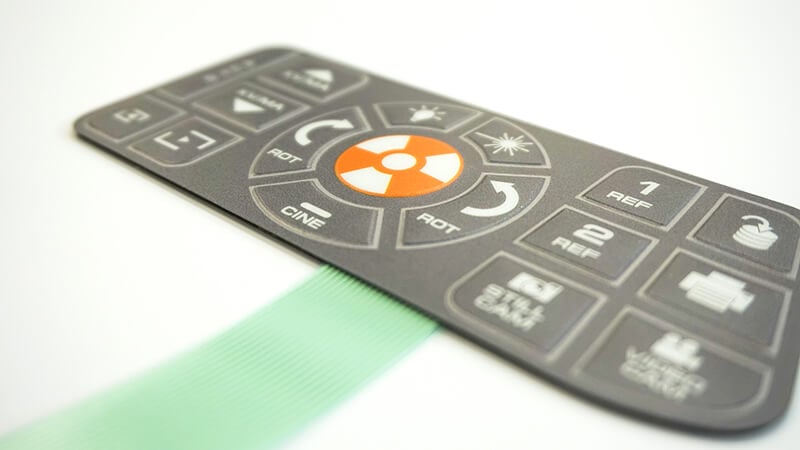The Total Guide to Membrane Switch Technology and Its Applications
The Total Guide to Membrane Switch Technology and Its Applications
Blog Article
Exactly How Membrane Layer Changes Contribute to the Sturdiness of Electronic Control Panels
Membrane buttons play a crucial role in enhancing the longevity of electronic control panels, primarily through their multi-layered building and construction which provides effective protection versus ecological elements such as moisture and dust. The absence of moving components considerably decreases the possibility of mechanical failures, making membrane layer changes perfect for requiring applications.
Meaning of Membrane Switches

Membrane layer buttons are developed to be slim and light-weight, making them ideal for applications where area is limited. They can be manufactured in various shapes, sizes, and colors, supplying adaptability in layout that satisfies visual and functional requirements. In addition, membrane buttons can incorporate various innovations, such as tactile comments and LED indications, enhancing customer experience.
Because of their construction, membrane buttons are typically immune to dirt, moisture, and basic wear, adding to their longevity in requiring atmospheres. Their smooth layout not just assists in easy cleansing but also lessens the danger of mechanical failing, making them a recommended option for manufacturers seeking reliable individual interfaces in their digital control board.
Protection Against Environmental Elements
The style of membrane layer switches naturally gives a level of security versus various ecological aspects, which is essential for maintaining capability in tough problems - Membrane Switch. These buttons are commonly built with layers of versatile materials that shield internal elements from wetness, dirt, and impurities. By encapsulating the wiring, membrane layer changes reduce the danger of short circuits and corrosion, which can substantially harm efficiency
Moreover, making use of durable adhesives and sealers during manufacturing boosts their resistance to environmental obstacles. Membrane layer buttons can withstand direct exposure to chemicals and solvents, making them appropriate for sectors such as food handling and healthcare, where health and cleanliness are critical. Their smooth surface area layout also stops the accumulation of dirt and bacteria, assisting in simpler cleansing and upkeep.
Temperature level changes are another ecological problem, and membrane switches are crafted to work effectively across a vast array of temperatures (Membrane Switch). This versatility makes certain that control panels stay operational in numerous setups, from industrial settings to consumer electronic devices
Effect On User Communication
User interaction with electronic control panels is dramatically affected by the design and performance of membrane buttons. These switches supply a tactile interface that improves the total individual experience, permitting user-friendly navigation and control. Their receptive nature ensures that individuals get prompt feedback upon activation, which is vital for tasks requiring accuracy and effectiveness.
Additionally, the smooth surface of membrane switches over assists in simple cleansing and upkeep, promoting user confidence in the reliability of the interface. This tidiness is specifically important in settings where hygiene is extremely important, such as medical or food processing settings. In Read Full Article addition, the compact and lightweight layout of membrane layer switches adds to the visual charm of control panels, encouraging customer engagement via a contemporary and smooth look.
Additionally, the assimilation of aesthetic aspects, such as published symbols and backlighting, helps users swiftly determine features, decreasing the learning curve connected with new tools. Therefore, individuals can operate devices better, bring about boosted efficiency and complete satisfaction. In recap, membrane layer buttons play an essential function in enhancing individual communication by integrating capability, appearances, and convenience of usage, inevitably causing enhanced functional effectiveness.
Style Adaptability and Customization
Design flexibility and modification are vital facets of membrane layer switches, allowing manufacturers to tailor electronic control panels to specific applications and customer needs. This flexibility enables the integration of different layout elements, such as shades, graphics, and structures, which can improve the aesthetic allure and customer engagement of the control board.
Membrane layer switches can be personalized in shapes and size, view website accommodating a large range of gadgets and applications, from industrial machinery to customer electronic devices. This flexibility makes sure that producers can develop user-friendly user interfaces that line up with customer assumptions and functional needs. Furthermore, the ability to incorporate one-of-a-kind attributes such as backlighting or tactile responses better boosts usability, enabling an extra interactive experience.
Furthermore, the manufacturing process for membrane switches over sustains the rapid prototyping of designs, allowing makers to repeat and improve their principles rapidly. This ability not only speeds up the advancement timeline but likewise makes sure that the end product fulfills details practical and aesthetic standards.

Cost-Effectiveness and Durability
Cost-effectiveness and durability are substantial benefits of membrane switches, making them an eye-catching choice for makers and end-users alike. These switches are commonly cheaper to produce than traditional mechanical switches, mainly because of their simplified production processes and the reduced variety of elements required. This price benefit expands not only to initial manufacturing yet likewise to long-term operational expenditures, as membrane layer buttons frequently call for less upkeep and have a lower failure price.
Moreover, the longevity of membrane changes adds to their total value. Constructed from resilient materials, they are resistant to ecological elements such as moisture, dirt, and chemicals, which can cause early wear in other button types. The absence of relocating components minimizes mechanical failure, allowing membrane switches to maintain performance over prolonged durations.
This sturdiness is especially helpful in applications needing consistent performance under demanding problems, such as clinical tools and commercial devices. Eventually, the combination of cost-effectiveness and long life makes membrane changes an economically viable choice for producers, supplying reliable remedies that withstand the examination of time while maximizing financial factors to consider.
Verdict
In verdict, membrane layer switches considerably improve the sturdiness of electronic control panels with their robust building you could try these out and protective functions - Membrane Switch. Generally, membrane switches over stand for a reputable and affordable selection for enhancing the long life and capability of digital control systems.
Report this page